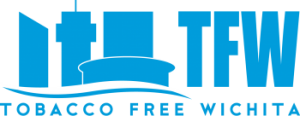Tobacco Retailer Initiatives

It’s Time to Clean Up Retailer Signs
Sign the LETTER OF SUPPORT here: https://forms.gle/VbASa6CstkDKyb397
Advertising impacts our neighborhoods and health. 
We are working to clean up retailer advertising that negatively influences youth and the community. This will reduce neighborhood blight and the influence of tobacco, alcohol and unhealthy food marketing, especially in lower-income neighborhoods in Wichita.
Benefits of Retailer Signage Reductions:
- Reduces youth exposure to tobacco, alcohol, and unhealthy food marketing.
- Improves the look of the neighborhood and can help reduce blight without requiring new development funds.
- Frees up retail window space, increasing interior visibility for retailer safety and allowing law enforcement to see potential criminal activity, making the store less of a target.
According to the Tobacco Control Legal Consortium, “Restricting all advertising regardless of what the advertising says is often referred to as a content-neutral restriction. An example of a content-neutral restriction is a law that requires retail stores to have no more than 25 percent of their windows covered by signage of any kind. Local governments are often well within their authority to regulate in a content-neutral manner, and such restrictions typically do not raise complicated legal concerns such as those associated with the First Amendment of the U.S. Constitution.”
FW’s 2016 Neighborhood Conversations
This past spring, Tobacco Free Wichita hosted seven Neighborhood Conversations for Wichitans, who are most often targeted by Big Tobacco. The goal was to educate the community about these ads and to ask if policies to reduce tobacco’s effect in our community could cause harm in oppressed areas. Almost half of the attendees of our meetings were smokers and nearly all lived in areas of Wichita where people are often the target of tobacco ads.
Here is what they had to say:
- Community members agreed that the City of Wichita’s current ordinance that helps ensure tobacco products are not sold to minors (Chapter 7.60.) should be updated to include inspections at locations that sell electronic cigarettes, vaping devices, hookah, and similar products.
- Attendees recommended restricting tobacco sales at least 1,000 feet from schools and parks.
- Attendees also felt that over-exposure to tobacco ads could encourage kids to start using and supported a policy to reduce the number of ads at stores AND restrict the location of ads.

Why is tobacco advertising such an important issue?
- Tobacco advertising targets consumers where they can immediately buy the product (a.k.a. the point of sale)
- Tobacco companies spend an estimated $71-M annually on advertising at the point of sale in Kansas.
- Increased youth initiation is directly correlated with the number of visits to tobacco retailers, particularly for youth in areas with high retailer density.
- TFW’s 2014 tobacco retailer audit revealed that 21% of tobacco licenses in Wichita are located in neighborhoods with the lowest average household income and 68% of retailers were within 1,000-feet of schools.
For information on policy options to reduce the impact of tobacco advertising, click HERE.
Typical tobacco advertising tactics used to hook new and existing users:
- Tobacco ads next to harmless ads (candy, snacks, soda)
- Bright packaging to make them look appealing and like other kid products
- Discounted prices to keep low income users hooked
- Tempts smokers who are trying to quit (outside advertisements)
For more information on point-of-sale tobacco advertising, visit:
ChangeLab Solutions – Tobacco Control
CDC’s – “Best Practices for Comprehensive Tobacco Control Programs”
We enjoy partnering with you in our challenge to reduce Big Tobacco’s influence in our community! If you are interested in helping TFW, please contact us at tobaccofreewichita@gmail.com .


Pingback: FDA Regulations for Sales to Minors in Effect as of August 8 | TOBACCO FREE WICHITA